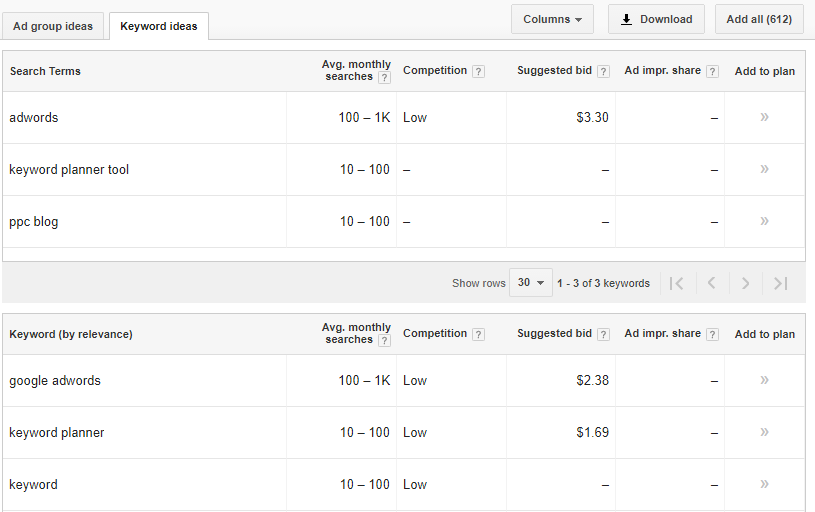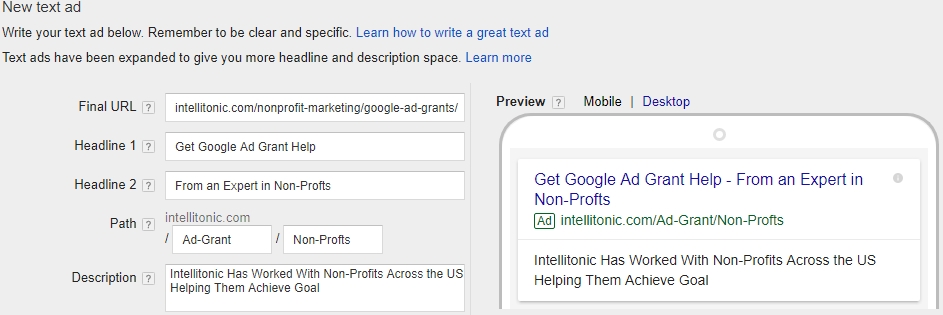Pay-per-click (PPC) advertising refers to ad campaigns that companies run on websites and social media platforms besides their own. Search engine marketing (SEM), a type of PPC, refers to paid ads that appear among organic results in search engines.
PPC works by paying ad publishers (e.g. Google AdWords, Facebook, LinkedIn) to display your text or visual ads. When users search for keywords you’ve bid on via PPC services, your ads appear and link to your selected landing pages.
A few things to consider about PPC services provided by search engines with the largest market shares:
- Google: the most commonly used search engine – it’s no surprise that Google AdWords is the most commonly used PPC service.
- Bing: uses Bing Ads, a service with a somewhat lower cost-per-click (CPC) that tends to represent an older demographic than AdWords.
- Yahoo: has Yahoo Gemini, which can import campaigns from AdWords and also has a lower CPC than the most commonly used PPC platform.
Testing ad campaigns on each of these channels can reveal the ideal demographics, CPC, and ad rankings for your company. More information on their differences can be found in the Further’s article on Profiling Google, Yahoo and Bing search demographics.
Here’s a hint for making your PPC campaign work: ideal demographics and CPC vary, but the ideal search ranking is at the top of the page. You’ll find it easier to meet these ideals when you’ve analyzed your keywords, site content, audiences, competitors, and ad content. Social PPC usually follows the same steps as its SEM equivalent, but with different options for audience targeting and mobile ads.
The diagram below provides a general path for constructing a PPC campaign, starting with keyword research:

PPC marketing and site content mutually benefit each other because they both rely on keyword research. Additionally, it’s generally accepted (but never explicitly stated by Google) that running an effective AdWords campaign can contribute to an improved SEO ranking. Certain steps in creating PPC ad campaigns require special attention to content on websites and social media.
For starters, effective keyword research relies on a strong understanding of your company’s priorities and service or product offerings. The most relevant thing to consider when choosing words is relevancy: the connection between keywords and your company’s product. This means choosing adjectives and nouns related to your location and services. After relevancy, select your keywords by high search volume and low competition. If you have a low budget, consider the estimated keyword costs, too.

Audience planning means developing personas based on such demographics as gender, age, income range, and location. Sufficiently understanding these in both ads and site content makes it more likely to get the right people on board. It also ensures that you don’t advertise hearing aids to young adults, or your local business to Timbuktu.
Landing pages need concise and compelling text to entice the visitor to complete your call-to-action. Too many calls-to-action may lose the audience just as easily as an unclear or weak one. Landing pages benefit greatly if they provide straightforward navigation to the rest of the site. They must also share keywords with the ads, and vice versa, as this creates a continuity of purpose and audience expectations. As Radiohead once put it, “no alarms and no surprises, please”.
When it comes to ad creation on its own, keyword research comes first. Drafting ads should occur after creating landing pages, and it takes audiences and competition into account.
Competitors concretely exist already, unlike the imaginary audiences. To recognize your top 3-5 competitors, look into the industry by location and your search ranking competition. You can find the latter in Google by searching “related:[your site URL]”. You can find their site content and ads on your own, and their keyword rankings and backlinks through programs like MajesticSEO and SEMRush. Their backlink profiles can be your backlink profiles if you reach out to the same sites and people. If you know which channels they use to gain site traffic, consider sharing the most effective ones they use or dominating the most effective ones they don’t use.
When drafting ad text, succinctness counts. Although your enthusiasm hopefully exceeds the level it indicates, one exclamation point works better than two or zero. AdWords performs best when you Capitalize Every Word (with the exception of articles like the and to) and include keywords in the display URL paths and ad text at least once. If you always have two slightly different ads running at once to A|B test, you can regularly create new ones based on effective performances and run a steady campaign.

Bidding on clicks rather than impressions via AdWords provides a clearer idea of your CPC and conversion costs versus value. Checking Google’s suggested bid after setting a minimum of $1 generally helps. You can rank for multiple keywords on a low budget by bidding on less expensive ones. Remember, marketers follow an unwritten rule that SEM counts toward overall traffic despite how often we differentiate “paid” from “organic”. This really puts the “oh” in SEO.
Our blog post on Market Analysis elaborates on how PPC services double as a source of valuable analytics. In short, analysis highlights areas for improvement in keywords, audience, CPC, and ads, allowing you to restart the process for new campaigns.
Ultimately, your PPC campaign ought to cycle through these steps to increase your CTR and conversion ratio. Besides bidding on less expensive keywords, good communication in landing pages and ads goes a long way in PPC marketing with budget constraints. Analysis and implementation matter equally: when you plan on the figurative paper and let ideas click into place, you’ll end up with a process pronounced “pay-per-click”.
